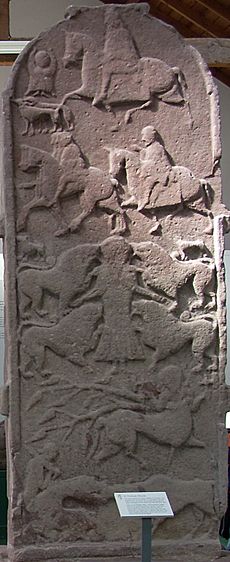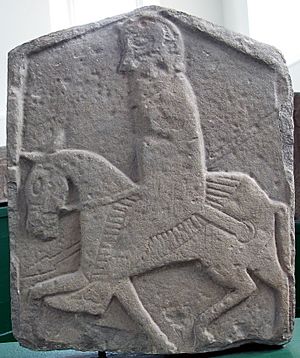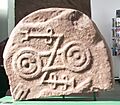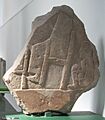Meigle Sculptured Stone Museum facts for kids
The Meigle Sculptured Stone Museum is home to a collection of 27 amazing carved stones from an ancient Scottish people called the Picts. You can find this museum in the village of Meigle, located in eastern Scotland.
The stones in the museum suggest that a very important church or monastery once stood nearby. Records from the 9th century mention a monk named Thana working in Meigle. He was likely a scribe in a local monastery that might have been founded in the 8th century.
All the stones were discovered near Meigle. Most were found in the churchyard next door. The old church was destroyed in a fire in 1869, but a man named William Galloway saved the stones. These stones are Christian monuments for the dead, likely for the powerful Pictish warrior families. The carvings show them with their weapons or on hunting trips.
Contents
The Museum Building
The museum is inside a building that used to be the village schoolhouse, built in 1844. A local landowner, Sir George Kinloch, bought the building in the late 19th century to keep the stones safe. In 1936, the museum was given to the state. It is now a protected historic building.
The Carved Stones
The stones at Meigle are incredible works of art. Most are from the 9th or 10th centuries and were used as tombstones. They are carved from a local red sandstone that is soft enough for detailed carving but can wear away over time.
About a third of the stones are "Class II" stones. This means they have both Pictish symbols and a Christian cross carved on them. The artists who made them probably used iron tools like chisels and hammers. They may have copied the designs from drawings in books.
Sadly, at least eight stones were lost over the years. Other pieces might still be buried in the churchyard or built into old walls.
Highlights of the Collection
The museum numbers each stone to keep track of them. Here are some of the most interesting ones.
Meigle 1
This tall stone is a cross-slab, meaning it has a cross carved on one side. Before the Picts carved it, it was a standing stone for about 2,000 years! On the back, there is a mix of symbols, including a hunting scene, a kneeling camel, a salmon, and a snake. It might be the oldest stone in the museum, possibly from the late 8th century.
Meigle 2
Standing almost 2.5 meters tall, this is a very impressive stone. One side has a unique cross with a large boss (a round bump) in the middle, surrounded by eight smaller ones. The other side shows the Bible story of Daniel in the lions' den.
Local legend tells a different story. It says the carving shows Queen Guinevere (called Vanora), the wife of King Arthur. The story goes that she was punished by being thrown to wild beasts. This stone was said to mark her grave.
Meigle 3
This gravestone shows a warrior on horseback. He is wearing a sword and carrying a spear. The carving might be a portrait of the person buried in the grave. The stone was cut down in the past and was once much taller.
Meigle 4
This stone is in pieces, but the parts that remain show amazing skill. It features detailed carvings of biting animals and twisting serpents. The back shows a horseman and several Pictish symbols.
Meigle 5
This small headstone has a cross with two animal heads carved at its base, which is very unusual. The back shows a single rider on a horse. One edge has two symbols: the "Pictish Beast" (a mythical creature) and a mirror.
Meigle 9
This is a tombstone that would have lain flat on the ground. It has carved panels on its sides. One side shows a griffin (a mythical beast with the body of a lion and the head of an eagle) and several twisting animals.
Meigle 10
This stone is now lost. It was destroyed in the church fire of 1869. It was a panel showing a horse pulling a carriage with a driver and two passengers. It also had a carving of an archer and several animals.
Meigle 11
This is the largest of the flat tombstones. One side shows three horsemen with a dog, and a strange figure with an animal's head holding two snakes. The other side has carvings of a dog, a bear, and other beasts.
Meigle 25
This is a "hogback" tombstone from the late 10th century. It is shaped like a house with a curved roof. The top ridge is carved into a long beast with a fish's tail. This style shows a connection to the Vikings, who also made hogback graves.
Meigle 26
This is a beautifully carved flat gravestone. It has a socket at one end where a standing cross would have been placed. The top is decorated with coiled snakes and sea-horses. The sides show a hunting scene, a griffin, and other strange beasts. One end is carved with a manticore (a mythical creature) and a person.
Other Notable Fragments
- Meigle 6, 7, and 8 are fragments of cross-slabs with key patterns and animal carvings.
- Meigle 12 is a flat gravestone with a fish monster and charging bulls.
- Meigle 22 is a piece of a frieze (a decorative band on a wall) showing a figure that might be a Celtic god or a siren with a fish-tail.
- Meigle 27 shows a person of high status sitting in a chair with a servant behind them.
- Many other stones, like Meigle 13 and 16-19, were lost over time. The remaining pieces give us a small window into the world of the Picts.
Images for kids
See also
- Eassie Stone
- Kilry Glen










